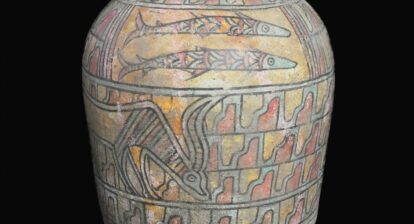Archaeologists have discovered a unique ritual installation dedicated to mass hunting of gazelles during the Neolithic, using gigantic traps known as ‘desert kites’. This is the earliest large-scale human built structures worldwide to date.
The archaeologists uncovered these stone-age hunting traps known as desert kites during their last season in October 2021. While such structures are common across the Middle eastern and south west asian arid landscapes (in central Saudi Arabia, through Jordan, Syria, Armenia, Turkey and as far as Kazakhstan), what makes these kites unique is their age. The researchers were able to date them to ca. 7000BC i.e they are 9,000 years old, which makes them “the earliest large-scale human built structures worldwide known to date,” said a statement by the Project. The site is in southern east Jordan, in the east of the Jafr basin in Jibal al-Khashabiyeh. It is part of the South Eastern Badia Archaeological Project (SEBAP) that has been working in the area for about a decade.

View of the desert kites’ guiding walls in Jordan. Photo: SEBAP
Previously, we wrote about thousands of stone structures, first discovered in the 1970s, and which are from 6500 to 2800 BC, which have been uncovered across the region, as well as the whole of the Arabian Peninsula. They range from burial markers, tower and pendant tombs and open-air structures, also known as gates (Mustatils) or desert kites.
These latest ones were found in Jordan and according to the project statement in UniversesInUniverse, “The settlements, represented by various organizations of semi-subterranean circular hut like dwelling units, provide during excavations an extremely rich and diversified material culture, with notably a specific lithic industry, which has led the team to define this occupation as a specific cultural entity termed the “Ghassanian” (in reference to a local toponym).”
This means that as opposed to the farmers in the Fertile Crescent, the Ghassanians were specialized hunters, and mass hunting of gazelle using these specialized desert kites traps was “at the center of their cultural, economic and even symbolic life in these marginal zones”. The hunters would drive animals into the enclosure, where the animals would be slaughtered.
There is something else that makes this site even more unique. During the 2021 season, archaeologists also discovered an exceptionally preserved and complex ritual installation inside one of the Ghassanian hunters’ campsites. Like the associated desert kites, this installation also dates back to the Neolithic period ca. 7000 BC, and features two steles with anthropomorphic features. The taller one is approximately 1.12 meters high, and depicts a desert kite, intermingled with the human figure. Other artifacts including animal figurines, flints, and around 150 arranged marine fossils were also found. According to the team statement, “The various finds, in addition to a ritual altar stone associated to a hearth, were organized within a reduced model of desert kite, built with stones in the middle of the campsite. This is the only architectural model of its kind known to date worldwide in a Neolithic context”, further adding, “This discovery is unprecedented, as it constitutes a unique testimony of a complex ritual arrangement, dating back to the Neolithic period.”

Detail view of the two steles of “Abu Ghassan” and “Ghassan”, with the ritual deposit of marine fossils at the background, at site JKSH P52, Jibal al-Khashabiyeh. © Photo: SEBAP

Detail views of “Ghassan” stele in site JKSH P52, Jibal al-Khashabiyeh area. © Photos: SEBAP
Such large standing anthropomorphic steles are not very common in the Near Eastern Neolithic, therefore these new finds provide rare examples of “some of the oldest artistic expressions in the Middle East”. The team believes that there is a ritualistic element to the structures “including an unexpected use of natural marine fossils in the symbolic and spiritual realm through the Neolithic. The altar and associated hearth suggest that some kind of sacrificial offerings must have been involved in the ritual process.”

General view of the discovered ritual installation at site JKSH P52, Jibal al-Khashabiyeh area. © Photo: SEBAP

View of the ritual deposit of marine fossils, within the ritual installation excavated at site JKSH P52, Jibal al-Khashabiyeh. © Photos: SEBAP
Evidently, mass hunting of gazelles was at the heart of the ritual activities of the hunters, to invoke “supranatural forces for successful hunts and abundance of preys to capture”.
This ritual complex centered around hunting is not only unique because of its high level of preservation, but also because it sheds new light on “the symbolism, artistic expression as well as spiritual culture of these hitherto unknown Neolithic populations specialized in mass hunting of gazelles using the desert kites”.
The project is a collaboration of Jordan’s Al Hussein Bin Talal University and the French Institute of the Near East.
TL;DR: Watch the less than one minute video that explains it all!







